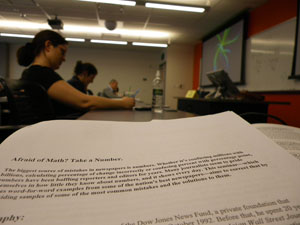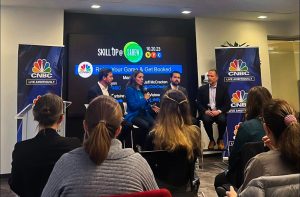Before Rich Holden became the executive director of the Dow Jones News Fund, he spent 20 years editing copy at The Wall Street Journal and The Asian Wall Street Journal. So when it comes to mistakes with numbers in stories, he has pretty much seen them all.
In the session, “Afraid of Math? Take a Number,” Holden took about 25 editors through his top tips aimed at ensuring numerical errors stay out of stories.
The session was part of the American Copy Editors Society’s annual conference held this week at Arizona State University’s Walter Cronkite School of Journalism and Mass Communication in Phoenix.
“The biggest source of mistakes in newspapers in numbers,” Holden said in the tip packet’s introduction. “Whether it’s confusing millions with billions, calculating percentage of change incorrectly or confusing percent with percentage point, numbers have been baffling reporters and editors for years.”
Holden’s session took journalists through 40 examples of mistakes made at top newspapers and then detailed how editors could avoid letting them slip into print.
Below are a few of the tips Holden shared:
Help readers understand the real meaning behind numbers in a story. When you are using numbers in a story, Holden said to make sure readers can visualize their exact scope. If your story reads “the land shrunk to 2.5 million acres,” find a way to give the number context. The wording could be reworked to “2.5 million acres, which is roughly the size of X.”
“Why would you as an editor allow numbers to go into a paper that are absolutely meaningless to 99 percent of your audience?” Holden said. “Don’t let them (journalists) get by with numbers that really don’t make sense whatsoever.”
Make sure your cursor touches every word to avoid major errors. Holden shared an example from a story that listed a building’s worth at $110, instead of $110 million. “This example made it through eight sets of eyes at a newspaper,” he said. “Your cursor should touch every word of the copy. If that had happened here, this mistake probably wouldn’t have happened.”
When using the terms such as “all-time record,” give readers context. In a story Holden edited years ago, he listed a benchmark as an all-time record for a company. Only problem – the company was just six quarters old. “The national editor took me aside and said, ‘This isn’t wrong, but it would have been helpful to have a sentence in there that said this company has only been around for a year and a half,'” Holden said.
Watch the verbs and adjectives you are using to describe a number. Don’t write that share prices “edged up” if they have actually skyrocketed. Make sure the words you choose accurately describe the numbers that follow.
Remember the difference between percent and percentage points. “Everyone gets it wrong, but you won’t anymore,” Holden said. “When you are comparing percent A with percent B, the difference is described in percentage points, not percent.”
Remember what came first. “As soon as you say something is the second largest, you immediately tell me what is the largest,” Holden said. “Any time you talk about the second largest, second tallest, second coldest, you gotta tell me what the largest is.











